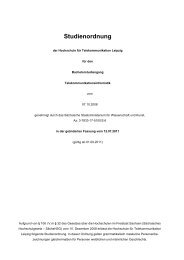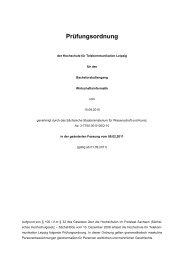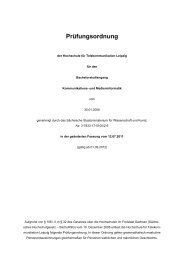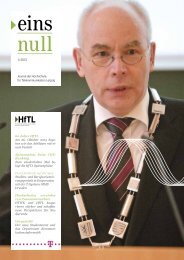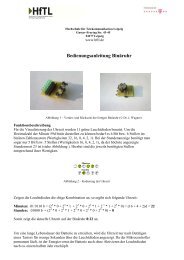CMU3 - Fast and Simple High-Resolution Optical Spectrum Analyzer
CMU3 - Fast and Simple High-Resolution Optical Spectrum Analyzer
CMU3 - Fast and Simple High-Resolution Optical Spectrum Analyzer
Create successful ePaper yourself
Turn your PDF publications into a flip-book with our unique Google optimized e-Paper software.
<strong>CMU3</strong>.pdf<br />
a2506_1.pdf<br />
© 2008 OSA / CLEO/QELS 2008<br />
<strong>Fast</strong> <strong>and</strong> simple high resolution optical spectrum analyzer<br />
Kai-Uwe Lauterbach, Thomas Schneider, Ronny Henker<br />
Hochschule fuer Telekommunikation Leipzig, Gustav-Freytag Str. 43-45, D-04277 Leipzig, Germany<br />
kai-uwe.lauterbach@hft-leipzig.de<br />
Max James Ammann, Andreas Thomas Schwarzbacher<br />
School of Electronic & Communications Engineering, Dublin Institute of Technology, Kevin Street Dublin 8, Irel<strong>and</strong><br />
Abstract: A simple method for fast optical spectroscopy with high resolution is shown. The<br />
method is based on the narrowb<strong>and</strong> Brillouin gain process in optical fibers.<br />
©2008 <strong>Optical</strong> Society of America<br />
OCIS codes: (300.6320) <strong>High</strong> <strong>Resolution</strong> Spectroscopy; (290.5830) Brillouin Scattering<br />
The measurement of the spectrum of optical sources is very important in science <strong>and</strong> technology. So, for instance in<br />
optical communication <strong>and</strong> transmission systems. Due to the nonlinear characteristics of optical components in such<br />
a system it is of prime importance to know the optical transmission spectrum.<br />
Commonly, diffraction grating based optical spectrum analysers (OSA) are used for this purpose. The typical<br />
resolution b<strong>and</strong>width of an OSA lies in the range of 0.06nm, which corresponds to 7.5GHz at 1550nm. In [1] a<br />
wavelength measurement method with a resolution b<strong>and</strong>width in the femtometer range was presented. The method<br />
relies on the high resolution of a Fabry-Perot interferometer. Another possibility is the self-heterodyne-beating [2],<br />
where the optical b<strong>and</strong>width is transformed into the electrical domain by the beating between the signal <strong>and</strong> a phase<br />
delayed copy of it. In this case the transformed signal can be measured by a PIN photodiode <strong>and</strong> a radio frequency<br />
spectrum analyzer. In [3] <strong>and</strong> [4] a new measurement method was described, which relies on the very small<br />
b<strong>and</strong>width of the Brillouin effect. This method allows a resolution b<strong>and</strong>width in the femtometer range. The<br />
achievable resolution depends on the spectral filtering of the Brillouin scattering [5]. The method is based on the<br />
change of the pump wavelength by either a tunable laser source [3] or a by a modulator [5]. The measurement time<br />
of both methods is rather low since it depends on the sweep time of the tunable laser or the frequency generator<br />
which defines the modulator frequency. Here we will present a simple method to reduce the sweep time of Brillouin<br />
based spectrum analyzers significantly. Furthermore, the method is very simple since it requires neither a modulator<br />
nor a tunable laser.<br />
The principal setup of our proof of concept is shown in Fig. 1. From the left side the unknown signal under test<br />
(S.U.T.) propagates through the st<strong>and</strong>ard single mode fiber (SSMF). From the other side the pump wave is injected<br />
into the same fiber via an optical circulator. All signals at the output of the SSMF are coupled into a photodetector<br />
on port 3 of the circulator. The electrical output voltage of the photodetector is measured by a digital sampling<br />
oscilloscope.<br />
Figure 1: Experimental setup. S.U.T. Laser: signal under test laser; SSMF: st<strong>and</strong>ard single mode fiber;<br />
C: circulator; PD: photodetector; DSO: digital sampling oscilloscope; EDFA: erbium-doped fiber<br />
amplifier; TEC: temperature controller; U/I: voltage-to-current converter<br />
As pump laser we used a conventional DFB laser diode (Anritsu, GB5A016) at 1538nm. The wavelength of the<br />
pump laser can be controlled by the laser diode injection current over the range of approximately 1nm. That<br />
corresponds to a frequency change of around 130GHz at 1538nm. The variation is realized by a sawtooth generator<br />
followed by a voltage-to-current converter. The emission wavelength of the DFB laser diode follows a nonlinear<br />
characteristic in comparison to the function of the sawtooth generator. Hence, the measured results have to be<br />
corrected.
<strong>CMU3</strong>.pdf<br />
a2506_1.pdf<br />
© 2008 OSA / CLEO/QELS 2008<br />
The injection current for the threshold of the DFB laser diode is 11mA <strong>and</strong> the maximum injection current is<br />
150mA. For this range the output power of the DFB laser diode is -1.85dBm for 11mA <strong>and</strong> 14.9dBm for 150mA.<br />
We stabilize the output amplitude of the DFB laser diode by using an EDFA in the automatic power control mode.<br />
Due to this, a stable amplitude over the tunable wavelength range can be achieved. The tunable emission wavelength<br />
of the DFB laser diode serves as the pump wave for the Brillouin process which produces a narrowb<strong>and</strong> Brillouin<br />
gain. This narrowb<strong>and</strong> Brillouin gain has a FWHM b<strong>and</strong>width of 23MHz for our SSMF <strong>and</strong> is 84,43pm upshifted in<br />
wavelength domain. The power of the pump wave is well below the threshold for stimulated Brillouin scattering.<br />
If the emission spectrum of the S.U.T. does not correspond with the Brillouin gain b<strong>and</strong>width the output voltage of<br />
the photodetector is nearly zero. If at least a part of the unknown S.U.T. spectrum is in the Brillouin gain b<strong>and</strong>width<br />
it will be amplified <strong>and</strong> the electrical output voltage at the photodetector begins to rise. This output voltage is<br />
recorded by a digital sampling oscilloscope (DSO) which is synchronized to the sawtooth generator. The DSO<br />
shows the intensity spectrum of the unknown S.U.T. laser if the nonlinear characteristic line is involved. The<br />
resolution of the DSO was adjusted to 250kSample/s. Hence, for the maximum wavelength range of 1nm (130GHz<br />
at 1538nm) the frequency distance between two sampling points at the DSO is approximately 1MHz.<br />
For the proof of concept we used an externally phasemodulated DFB Laser as the S.U.T. laser at 1538nm. The<br />
measured optical spectra are shown in Fig. 2. In the left figure the external modulator was driven by a 3.2GHz<br />
sinusoidal signal. The measurement plot for a 3.2GBit/s non-return-to-zero (NRZ) pseudo-r<strong>and</strong>om-binary signal<br />
(PRBS) is shown in the right part of Fig. 2.<br />
Figure 2: Measurement results, left figure: 3.2GHz sinusoidal modulated signal, right figure: 3.2GBit/s<br />
PRBS NRZ modulated signal<br />
The resolution b<strong>and</strong>width of our measurement method depends on the gain-b<strong>and</strong>width of the Brillouin process in the<br />
fiber. Hence, for the SSMF in our setup the resolution b<strong>and</strong>width is 23MHz. Special fibers such as AllWave <strong>and</strong><br />
TrueWave have a Brillouin gain b<strong>and</strong>width of only 11.4 <strong>and</strong> 12.4 MHz [5]. The minimum achievable sweep time<br />
depends on the regulation speed of the EDFA output power. The frequency of the sawtooth generator was adjusted<br />
to 100Hz. Therewith the sweeptime is 10ms over the whole tunable wavelength range. In our case a decrease of the<br />
sweep time was not possible because of the EDFA regulation speed. In order to reduce the measurement time<br />
drastically the method can be used without an additional EDFA. In this case the nonlinear characteristic of the<br />
Brillouin amplification in dependence on the Laser injection current has to be included in the measured results.<br />
We have shown a very simple <strong>and</strong> potential fast measurement method for the optical spectrum analysis with a<br />
resolution in the femtometer range. Furthermore, this method has the potential to increase the sweep frequency up to<br />
the maximum modulation frequency of the used pump laser diode.<br />
References:<br />
[1] T.R. Parker, M. Farhadiroushan, “Femtometer resolution optical wavelength meter” IEEE Phot. Technol. Lett.<br />
Vol. 13, No.4, pp.347- 349, 2001<br />
[2] J. A. Constable <strong>and</strong> I. H. White, “Laser linewidth measurement using a Mach-Zehnder interferometer <strong>and</strong> an<br />
optical amplifier”, Electron. Lett. Vol. 30, No.2, pp. 140-141, 1994.<br />
[3] J. M. Subias Domingo, J. Pelayo, F. Villuendas, “Very <strong>High</strong> <strong>Resolution</strong> <strong>Optical</strong> Spectrometry by<br />
Stimulated Brillouin Scattering”, Phot. Tech. Let. Vol. 17, No.2, pp. 855-857, 2005.<br />
[4] Th. Schneider, “Wavelength <strong>and</strong> line width measurement of optical sources with femtometre resolution”<br />
Electron. Lett. Vol. 41, No.22, pp.1234-1235, 2005.<br />
[5] A. Yeniay, J.M. Delavaux, <strong>and</strong> J. Toulouse, “Spontaneous <strong>and</strong> stimulated Brillouin scattering gain spectra in<br />
optical fibers”, J. Lightw. Technol., Vol.20, No.8, pp. 1425-1432, 2002.








